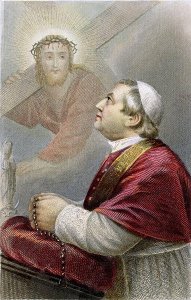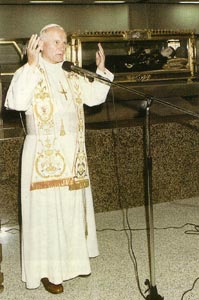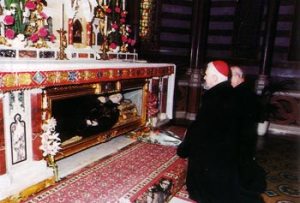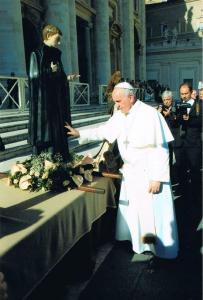
Blessed Pius IX
Sante Possenti, the saintly father of St. Gabriel was a distinguished lawyer and worked in various positions in the administration of the Papal States. Sante was made governor of Umbria when barely twenty years old before his occupation took him to Assisi and thence to Spoleto. He had a close working relationship and friendship with Blessed Pius IX. In the life of St. Gabriel we read that the Blessed Pope visited the region in which St. Gabriel’s Passionist community was residing. The community elected to forgo greeting the Holy Father as a sacrifice to offer to God for the health and well-being of the pope. During the difficult years of Italian unification St. Gabriel offered up many prayers and sacrifices for the Pope-King.
Pope Pius governed the Church during the troubled times of the Unification of Italy. He defended the independence of the Church against modernism and creeping secularism. At the Vatican Council he pronounced the dogma of Papal Infallibility. A great devotee of Our Blessed Lady, he promulgated the dogma of the Immaculate Conception. Pius IX could indeed be described as a Marian Pope; in the Encyclical Ubi Primum he defended the recognition of Our Lady as Mediatrix of Salvation. He was beatified in 2000.
Pope Leo XIII acceded to many requests from around the world to open the process for the beatification of St. Gabriel on July 7th 1896. This holy pope was a great friend of the Passionist Congregation and had known Blessed Dominic Barberi in Belgium. He showed a particular interest in the cause of St. Gabriel and, in an extraordinary display of his personal interest, waived the need for evidence of Gabriel’s reputation for sanctity; “It is as clear as the sun that his renown is at this moment spread abroad everywhere, and is increasing day by day”. Leo XIII especially desired that St. Gabriel should provide an example to novices and young religious and said; “Because of his filial love for Mary at the foot of the Cross, Gabriel deserves to take his place by the side of St. John the Beloved Disciple, to whom Christ in His dying hour commended His Mother”.
St. Pius X declared Gabriel ‘Venerable’ on 14th May 1905, comparing his virtues to those of SS. Aloysius Gonzaga, Stanislaus Kostka and Jan Berchmans. After the positive affirmation of two miracles attributed to the intercession of St. Gabriel and waiving the normal delay of fifty years between death and beatification Pope Pius X declared the beatification of Gabriel by the brief ‘Mirabilis’ of 3rd May 1908. The solemn beatification of Gabriel took place on 31st May 1908 at St. Peter’s, presided over by the saintly pope and in the presence of Fr. Norbert, Michael Possenti and many of Gabriel’s former classmates and friends. Pope Pius X fixed the feast of Blessed Gabriel for the 31st May (later moved to February 27th) – the last day of the month of Mary and extended its celebration to the Passionist Order and all its houses and churches as well as to the diocese in which the sanctuary of St. Gabriel is situated.
It was the pope of the First World War, Pope Benedict XV who canonised St. Gabriel on 13th May 1920, being Ascension Day. The two miracles necessary for the canonisation were the instantaneous healings of Giovanni Battista Cerro and Luigi Parisi. The canonisation of St. Gabriel took place at the same time as St. Margaret Mary Alocoque and was attended by his brother Michael Possenti as well as Brother Sylvester who had been in the novitiate with St. Gabriel.
The sanctuary of St. Gabriel was elevated to the rank of a minor basilica by Apostolic Letter of Pope Pius XI in July 1929. In 1932 he extended the Mass and Office of St. Gabriel to the Universal Church, to be celebrated each 27th February (28th February in leap years), in response to the request of many bishops and cardinals. In June 1926 he spoke of the strong influence that the example of St. Aloysius had had on the spiritual life of St. Gabriel.
Saint John XXIII was especially devoted to St. Gabriel. In 1959 he solemnly declared St. Gabriel to be the patron of the region of Abruzzo by the Apostolic Letter ‘Quantum dilectionis’ praising St. Gabriel’s powerful intercession and devotion to the Holy Passion. At the closing of the fourth session of the preparatory commission for the Second Vatican Council, in February 1962 he once again proposed St. Gabriel as a model of Christian perfection and spoke of his own devotion to St. Gabriel springing from an image of the saint he saw at SS. John and Paul in Rome (the Generalate of the Passionists) when he was on retreat before his own ordination to the priesthood. For the centenary year of St. Gabriel’s death he wrote the letter Sanctitatis altrix to the superior general of the Passionists. In this letter he spoke of the universal appeal of St. Gabriel; his holiness, his devotion to Mary, and his cheerfulness.
 Saint John Paul II visited the shrine of St. Gabriel on 30th June 1985 – a video compilation of his visit can be seen here. Addressing the young people who had come to the shrine Pope John Paul II referred to St. Gabriel as the ‘saint of the smile’ and spoke of his characteristic joy. “In accordance with the proper charism of the Congregation of the Passion of Jesus Christ , he found the secret of its perfection in the meditation of the crucified Christ and his Mother of Sorrows at the foot of the Cross. In the school of Jesus and Mary, he was able to achieve in the short space of a few years the highest peaks of perfection with admirable momentum: “to Jesus, through Mary””. To the Passionist community of Isola del Gran Sasso he spoke of St. Gabriel as the ‘glory of the Passionist Congregation’; “The example of the dear young Passionist, teaches that you must surrender with extreme humility and obedience to the “grace” of God: He wants our love!” After his visit to the shrine Pope John Paul II spoke twice more of St. Gabriel. In October 1990 he recalled St. Gabriel as “Son of the governor of Assisi, brilliant dancer, Gabriel left everything and became a Passionist, having understood that only the love of Christ crucified and his sorrowful Mother can redeem man from his earthly sadness and unhappiness.”. In 2003 he declared “By the shining example of St. Gabriel, you, dear young people, draw the courage to be faithful disciples of Christ”.
Saint John Paul II visited the shrine of St. Gabriel on 30th June 1985 – a video compilation of his visit can be seen here. Addressing the young people who had come to the shrine Pope John Paul II referred to St. Gabriel as the ‘saint of the smile’ and spoke of his characteristic joy. “In accordance with the proper charism of the Congregation of the Passion of Jesus Christ , he found the secret of its perfection in the meditation of the crucified Christ and his Mother of Sorrows at the foot of the Cross. In the school of Jesus and Mary, he was able to achieve in the short space of a few years the highest peaks of perfection with admirable momentum: “to Jesus, through Mary””. To the Passionist community of Isola del Gran Sasso he spoke of St. Gabriel as the ‘glory of the Passionist Congregation’; “The example of the dear young Passionist, teaches that you must surrender with extreme humility and obedience to the “grace” of God: He wants our love!” After his visit to the shrine Pope John Paul II spoke twice more of St. Gabriel. In October 1990 he recalled St. Gabriel as “Son of the governor of Assisi, brilliant dancer, Gabriel left everything and became a Passionist, having understood that only the love of Christ crucified and his sorrowful Mother can redeem man from his earthly sadness and unhappiness.”. In 2003 he declared “By the shining example of St. Gabriel, you, dear young people, draw the courage to be faithful disciples of Christ”.
 During his tenure as Prefect of the Sacred Congregation for the Doctrine of the Faith, Joseph Cardinal Ratzinger, later Pope Benedict XVI, visited the shrine of St. Gabriel and prayed before his sacred relics. For the 150th anniversary of death of St. Gabriel he gave special indulgences to pilgrims visiting the shrine and to devotees. He had been invited to consecrate the new shrine church but had resigned the Apostolic See before the consecration was due to take place.
During his tenure as Prefect of the Sacred Congregation for the Doctrine of the Faith, Joseph Cardinal Ratzinger, later Pope Benedict XVI, visited the shrine of St. Gabriel and prayed before his sacred relics. For the 150th anniversary of death of St. Gabriel he gave special indulgences to pilgrims visiting the shrine and to devotees. He had been invited to consecrate the new shrine church but had resigned the Apostolic See before the consecration was due to take place.
 Pope Francis spoke of St. Gabriel in February 2014 proposing him as a model of sanctity for all Christians in their varied vocations and lives; “[his] example helps you, dear young people, to be enthusiastic disciples of Jesus, who inspires you, dear sick people, to offer your suffering in union with those of Christ; and stimulates you, dear newly-weds, to make the Gospel the fundamental rule of your married life”. In September 2014 Pope Francis was represented at the consecration of the new sanctuary of St. Gabriel by Cardinal Antonelli and wrote a letter to be delivered by the Cardinal at the consecration . The Holy Father had previously, on 17th September 2014, blessed a chalice and paten to be used at the Mass of Consecration by Cardinal Antonelli.
Pope Francis spoke of St. Gabriel in February 2014 proposing him as a model of sanctity for all Christians in their varied vocations and lives; “[his] example helps you, dear young people, to be enthusiastic disciples of Jesus, who inspires you, dear sick people, to offer your suffering in union with those of Christ; and stimulates you, dear newly-weds, to make the Gospel the fundamental rule of your married life”. In September 2014 Pope Francis was represented at the consecration of the new sanctuary of St. Gabriel by Cardinal Antonelli and wrote a letter to be delivered by the Cardinal at the consecration . The Holy Father had previously, on 17th September 2014, blessed a chalice and paten to be used at the Mass of Consecration by Cardinal Antonelli.
